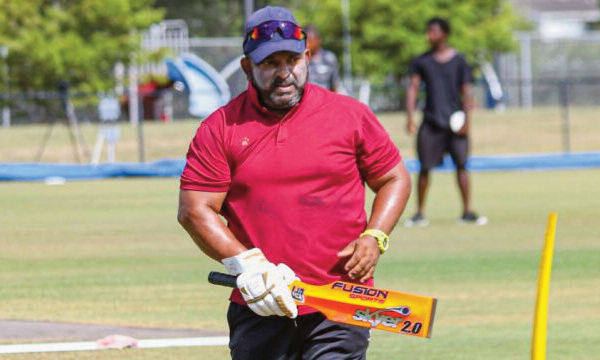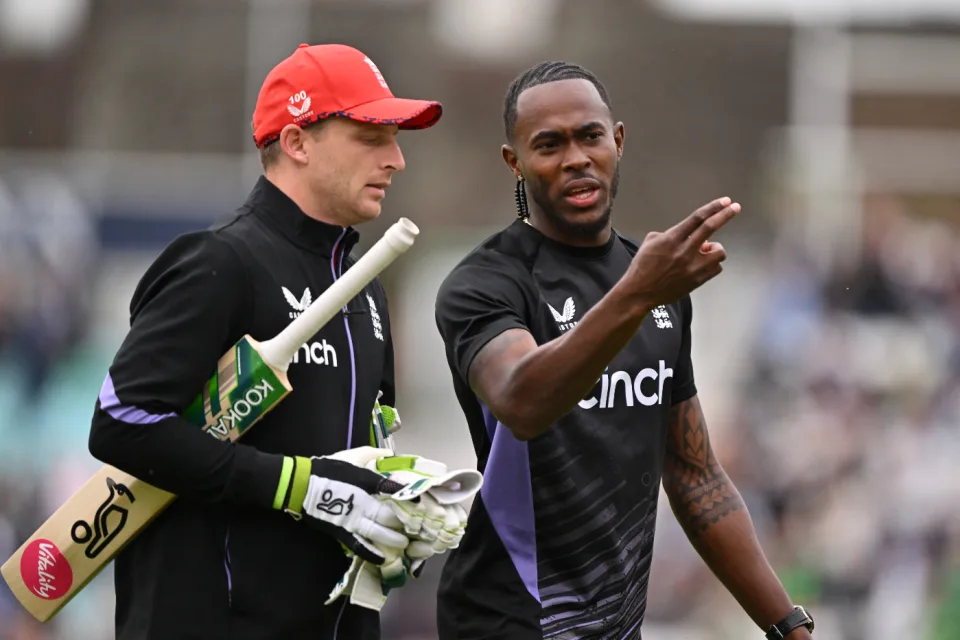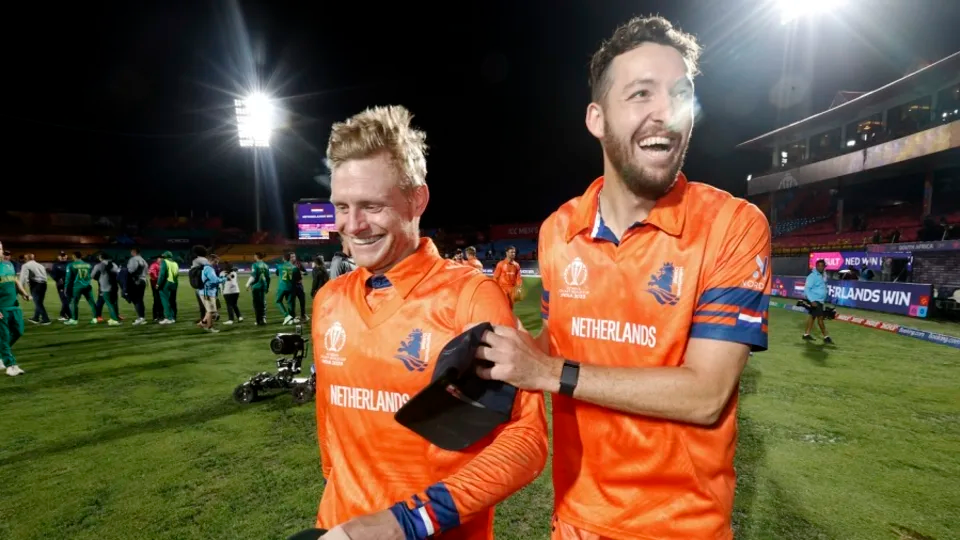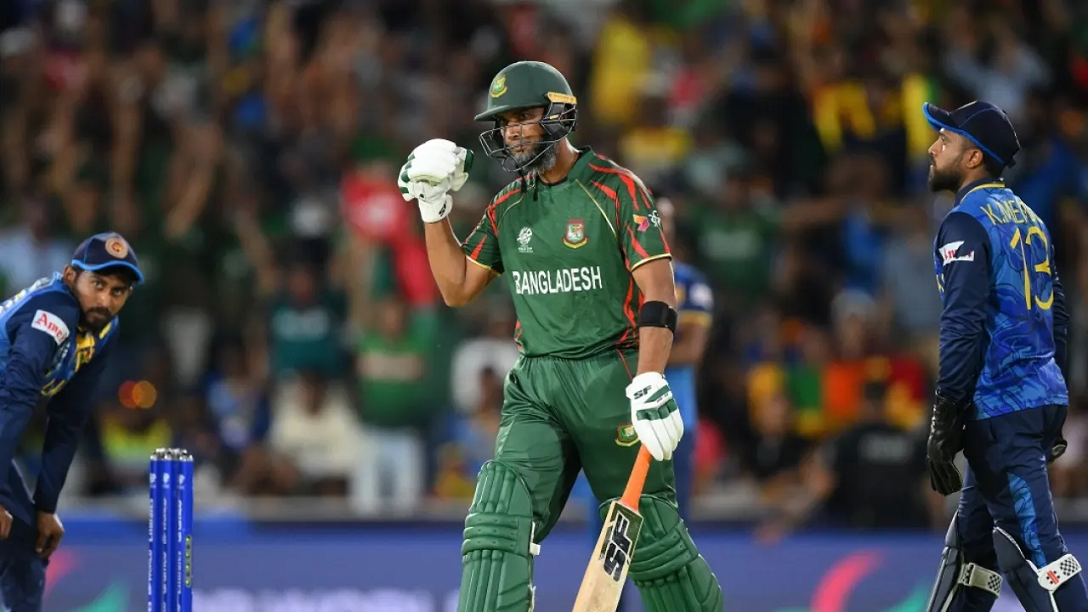Sports
Pubudu Dassanayake resigns as Nepal head coach, takes up role with Canada

Pubudu Dassanayake has submitted his resignation as Nepal head coach citing “family reasons” with almost a year and a half left on his current contract in order to take up the same position with Canada. His contract with Canada will run until the end of 2023.
Dassanayake, 52, played Test cricket for Sri Lanka in the mid-1990s before migrating to Ontario in 2001. He eventually made his debut for Canada at the 2005 ICC Trophy in Ireland and helped them qualify for the 2007 World Cup. He went on to become the head coach of Canada for the first time from 2007 until the end of the 2011 World Cup, Canada’s last appearance in the 50-over ICC showpiece event, before taking up the Nepal head coach job for the first time, in 2011. He held the job until 2015, leading Nepal to their first T20 World Cup in 2014.
He coached USA from 2016 until 2019 before taking up the Nepal job for a second time in December 2021. But Dassanayake says that family considerations in a post-Covid world have forced him to reconsider his priorities.
“The one thing is that during the Covid time period, I was totally away from cricket,” Dassanayake told ESPNcricinfo. “My wife’s job, she got very busy during that time. She’s a practising veterinarian in Canada. She got really busy and I also got involved with that. In that period, once Covid is slowing down I got this offer from Nepal. Since I was away from cricket for a while, I wanted to get something going because that’s my passion. I was happy to jump in and help Nepal and put things in the right direction. So after a long break, I accepted the job.
“When I was in Nepal the last time between 2011-2015, it was different. I was so pumped up to do lots of things and my family was happy for me to go and work in my career. Now we are in a situation where my kids need my support for lots of other things when it comes to education. My mother-in-law also got sick in the last two months. So all of these things contributed to me thinking about the whole situation. My wife is managing all these things with her work. For me to be far away from there, it’s putting pressure on me and on all of us because I’m not there when the family needs me. I’m staying in hotels. I go from the hotel to the ground and back to the hotel the rest of the time. That lifestyle is not helping me.”
Dassanayake said he attempted to submit a resignation letter to the Cricket Association of Nepal before Nepal’s recent ODI tour of Scotland, where they won one of four matches against Scotland and Namibia. The board asked him to reconsider, and he continued leading the team on tour. Upon returning with the team to Kathmandu earlier this week, he had a meeting with the board where they accepted his resignation.
“It would be unfair if I just left like that because the Scotland tour was back-to-back after the USA tour,” Dassanayake said, referring to Nepal’s prior ODI tour to Texas in June as part of ICC Cricket World Cup League Two. “These thoughts came in around the first week of July. When I was convinced what I wanted to do, I sent a letter to the Cricket Association of Nepal. But I didn’t say anything to the playing group. I just wanted them to focus on cricket and complete this tour.
“Normally when I’m given a challenge, I don’t leave halfway. I’m a person who really wants to see things through and take teams into a good era from tough times. If I talk about Nepal before, Canada earlier and even USA, if you see the pathway, I took more than a year to go down and come back again because the changes we put in place take time to bear fruit. Nepal is also in a situation where we have done a lot of changes and I was confident if I was there for the next 12 months, they are basically heading into a top team with this young group and the talent they have. We just need to have patience with them.”
‘Nepal has come a long way in a short period with a young group’
During his stint, Dassanayake had to spend a significant amount of time and energy to smooth over simmering disputes between players and the cricket board that took their attention away from their ability to perform on the field.
“When I was here in Nepal before [from 2011-2015], one thing that I never had was issues within the playing group. They were one team and they were very focused on winning, giving their 200% to win games. When I came this time, I’ve seen there’s a lot of small groups. The thinking was totally different. Some period of time has contributed to that in Nepal. Whatever it was, I’m not sure. The focus wasn’t there for playing cricket. There was so much of other issues around the system. It took some time to clear that.
“When we were in Oman for the T20 World Cup Qualifier, it was right in the middle of it but we managed to do things there to get the best out of the team. Then tour by tour, we did a lot of outside cricket workouts to get people into the right frame of mind, it’s the national team and we need to play together to win matches for the country. So I think we’ve come a long way in a short period with a young group, and a young captain, but there’s still a long way to go.
Despite these clashes, Dassanayake believes the right nucleus of players is in place to achieve successful results on the field. Apart from captain Sandeep Lamichhane, Dassanayake also has a lot of faith in 19-year-old vice-captain Rohit Paudel and 17-year-old No. 3 batter Dev Khanal.
“When I came to Nepal, there were a lot of clashes between the organisation and the players,” Dassanayake said. “There was no real dialogue between the players and the new board. Both sides were very adamant about lots of things. I was able to mediate because I am very close to the playing group and the board gave me the assurance that whatever way I want to do things, they will back me up. We put the playing group in the right direction. The board was very supportive. Once the board saw the young talent coming through, they were very confident with what we are doing. From their side, they increased the player salaries, their match fees, their daily allowance. We had to drop a few senior players at the beginning because of the whole issue.
“The reason we are losing games, some of these top-order batters who are 17 and 19 years old haven’t played enough cricket at this level. It will take a bit of time, but I think the best talent has been picked and it’s just that we need to put them into a good program for them to perform. I have seen all these Associate countries in World Cricket League Two. From talent wise, they are not far from anyone. They just need to get experience and settle down in this level and learn how to handle situations. Even if I’m not here, I’m still going to support the youngsters.”
His first assignment with Canada will be the second round of ICC Cricket World Cup Challenge League A, which is set to run from July 27 to August 6. Canada is at the top of the six-team table with four wins from their first five matches, and they will host Singapore, Qatar, Denmark, Malaysia and Vanuatu in the event.
(Cricinfo)
Sports
England face Australia in the battle of champions

The first truly heavyweight clash of this expanded T20 World Cup format comes freighted with both history and subplots. A rematch of the 2010 World T20 final at Kensington Oval, the match pits Jos Buttler’s defending champions – who are aiming to become the first team to retain the trophy – against the Australian winning machine, victors at the 2021 edition and current world title-holders in Test and ODI cricket. And that’s before you throw in the Ashes for afters.
Already there is added pressure on England, after the rain in Bridgetown led to a share of the points in their opener against Scotland (and that having conceded 90 runs from 10 overs without taking a wicket in a tepid bowling display). Lose to their oldest rivals and it will leave their Super 8 prospects open to being waylaid by the perils of net run-rate calculations, or worse.
The Scotland match was the third abandonment in five suffered by England, after a rain-affected home series against Pakistan, which has clearly hampered their readiness for this campaign after almost six months without playing T20 together. It does not take much for a side to click in this format – and England looked in decent shape when they did get on the field against Pakistan – but Buttler will be anxious for things to go their way on Saturday, if only to avoid further questions referencing the team’s disastrous ODI World Cup defence last year.
Australia, under the laidback leadership of Mitchell Marsh would love nothing more than to add to the English sense of jeopardy – having helped bundle them out of the tournament in India on the way to taking the crown. Their head to head record is less impressive in T20 however, with England having won six of the last seven completed encounters, as well as that 2010 final.
Despite a wobble with the bat, Australia avoided mishap against Oman earlier in the week, the experience of David Warner and Marcus Stoinis shining through in difficult batting conditions. Surfaces in the Caribbean – not to mention those games staged in the USA – have already had teams scratching their heads; rather than the “slug-fest” England had prepared for, following a high-scoring tour of the Caribbean in December, it looks as if boxing smart may be the way to go.
Speaking of Warner, this could be the last time he faces up against England in national colours – and another match-winning contribution would likely reduce the chances of them meeting again in the knockouts. On the other side of the card is Jofra Archer, fresh from an emotional maiden outing at Kensington Oval and ready to take on Australia for the first time in any format since 2020. Can Mark Wood fire up England’s campaign, as he did during last summer’s Ashes? Will Pat Cummins be back to harass the old enemy once again? Seconds out, it’s almost time to rumble.
Cummins is set to return after being rested for the Oman game, which saw Mitchell Starc leave the field with cramp. Starc is understood to be fine and could keep his place – which would likely see Nathan Ellis miss out. Marsh is still not fit to bowl, with Australia likely to continue with the allrounder combination of Stoinis and Maxwell to give them cover.
Australia (probable XI): David Warner, Travis Head, Mitchell Marsh (capt), Glenn Maxwell, Marcus Stoinis, Josh Inglis (wk), Tim David, Pat Cummins, Nathan Ellis/Mitchell Starc, Adam Zampa, Josh Hazlewood
The one change England may consider is Reece Topley coming in for Wood, with the expectation that there will be some rotation among the seamers through the course of the tournament.
England (probable XI): Phil Salt, Jos Buttler (capt & wk), Will Jacks, Jonny Bairstow, Harry Brook, Liam Livingstone, Moeen Ali, Chris Jordan, Jofra Archer, Adil Rashid, Reece Topley/Mark Wood
[Cricinfo]
Sports
South Africa up against their bogey team in batter-unfriendly New York

Once is coincidence, twice is a clue, and three times is proof.
To paraphrase Agatha Christie, that is the narrative around South Africa’s meeting with Netherlands at this T20 World Cup.
The Dutch beat South Africa at the 2022 tournament and ended their semi-final hopes in a match where South Africa appeared to be sleep walking, and then beat them again at the 2023 ODI World Cup, where they exposed South Africa’s vulnerability in the chase. If they to do the treble, not only will Netherlands take the lead in Group D, but they will offer conclusive evidence of the threat they pose to Full Members, especially South Africa.
Of course, it will take some doing after South Africa’s opening performance against Sri Lanka, where they reduced their opposition to their lowest T20I total and chased it down in fairly straightforward fashion thanks to the most stable middle-order of their white-ball era. In Aiden Markram, Tristan Stubbs, Heinrich Klaasen and David Miller, South Africa have bankers and big-hitters and, for this match, they also have the advantage of experience. They’ve already played at Eisenhower Park, and have first-hand knowledge that run-scoring doesn’t come easily;Klassen said they are prepared to use their “cricket brains” and play “smarter cricket”.
But the conditions could be good news for Netherlands, who are not naturally a line-up of big hitters and build their innings on a foundation of turning ones into twos. In other words, they tend to take a slightly more conservative approach to batting, which may work well here, but they’ll be wary of the uneven bounce of the surface and will have to come up with plans to counterattack especially against South Africa’s seamers. Their own bowlers were exemplary in Dallas and will look to build on that performance against a line-up that will likely be more proactive than Nepal’s, but who they have managed to keep quiet not once, but twice in the past. Third time’s the charm, they say.
Anrich Nortje’s stunning return to form against Sri Lanka means South Africa may not have to tinker with the bowling combination, and Gerald Coetzee and Tabraiz Shamsi may have to wait their turns to get a game. The batting line-up should be unchanged, with no space for Ryan Rickelton yet.
South Africa: Quinton de Kock (wk), Reeza Hendricks, Aiden Markam, Tristan Stubbs, Heinrich Klaasen (wk), David Miller, Marco Jansen, Keshav Maharaj, Kagiso Rabada, Ottneil Baartman, Anrich Nortje
Conditions in New York may tempt Netherlands to include an extra seamer and they have Kyle Klein in their squad. But it could come at the expense of a shortened batting line-up and they may not want to risk that.
Netherlands: Michael Levitt, Max O’Dowd, Vikramjit Singh, Sybrand Engelbrecht, Scott Edwards (capt, wk), Bas de Leede, Teja Nidamanuru, Logan van Beek, Tim Pringle, Paul van Meekeren, Vivian Kingma
[Cricinfo]
Latest News
Mustafizur, Rishad, Hridoy dazzle in Bangladesh’s tight two-wicket win over Sri Lanka

Nuwan Thushara’s last over brought Sri Lanka screaming back into the match,as he first bowled Rishad Hossain, and then nailed Taskin Ahmed in front of the stumps with a pinpoint swinging yorker. This left Bangladesh eight wickets down, with 12 runs still to get.
However, the experienced Mahmudullah was at the crease for Bangladesh, and despite some further nervy moments, pushed Bangladesh across the line off the last ball of the 19th over.
But this was a match chiefly decided by Bangladesh’s own outstanding bowling. Mustafizur Rahman was the best among them, using shorter lengths and his cutters efficiently, to claim figures of 3 for 17. Rishad Hossain’s three-for through the middle overs also kept Sri Lanka quiet.
Mustafizur was instrumental in Sri Lanka’s downward spiral through the middle overs, which culminated in a crash-and-burn end. Ultimately, their inability to find boundaries, or even rotate strike against good Bangladesh bowling resulted in their downfall. A score of 125 for 9 always seemed poor on a decent pitch, even if their bowlers made a match of it in the end.
Brief scores:
Bangladesh 125 for 8 in 19 overs (Towhid Hridoy 40, Litton Das 36; Dhanajaya de Silva 1-11, Nuwan Thushara 4-18, Wanidu Hasaranga 2-32, Matheesha Pathirana 1-27) beat Sri Lanka124 for 9 in 20 overs (Pathum Nissanka 47, Dhananjaya de Silva 21; Tanzim Hasan Sakib 1-24, Taskin Ahmed 2-25, Mustafizur Rahman 3-17, Rishad Hossain 3-22) by two wickets
[Cricinfo]












